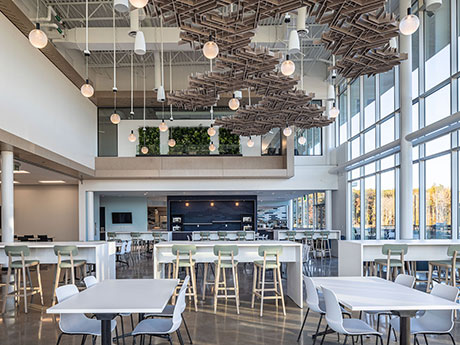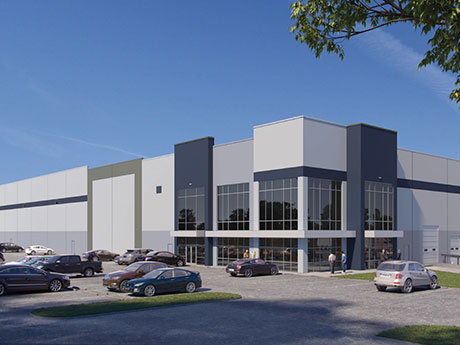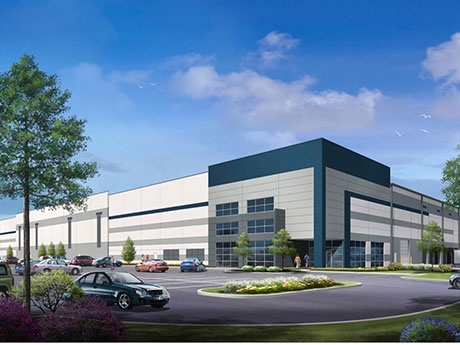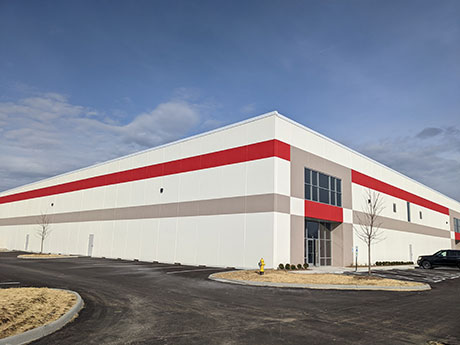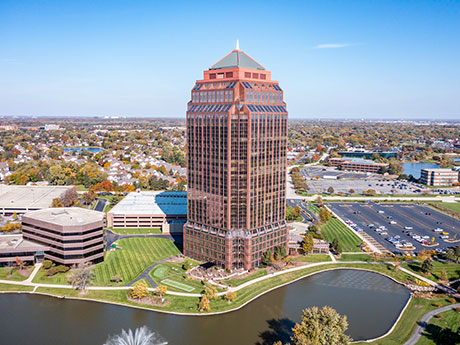By Rob Roe and Jessica Urbin, JLL What does the future of the office in Cleveland look like? While there isn’t one straightforward answer, there’s no doubt that the office of today looks much different than it did five years ago. Though some companies still maintain a traditional office space, the onset of hybrid work has indisputably changed the way many companies use — and choose — their real estate. This adoption of hybrid work has driven the market’s evident transformation. Smaller office spaces As companies adopt hybrid work models, the need for larger office spaces decreases. This doesn’t mean companies are eliminating their office real estate, though. In fact, 60 percent of office workers want to work in a hybrid style today, and 55 percent are doing so already. These downsized spaces support this work model by creating shared spaces, such as cubicles or lockers, as well as incorporating more conference rooms and small team rooms to hold private video calls. They also encourage something employees can’t get at home: in-person collaboration. New spaces are being outfitted with intentional spaces to meet, such as lounge areas, desks in open areas, cafés and more. In addition, having small spaces doesn’t …
Ohio
By Alec Pacella, NAI Pleasant Valley The Cleveland industrial market enjoyed a strong first half of 2022, characterized by record-low vacancy rates, brisk new construction and increased rental rates and sales prices. Although the market has made several headlines over the first six months, many of these trends began several years ago and the pandemic only accelerated the activity level amongst several key sectors. Market wide, the average vacancy rate was just over 4 percent at the mid-year mark, which is a slight decrease from the 4.5 percent rate at the end of last year. By most accounts, this is a record-low level and represents a decrease of two full percentage points over the last five years. The most popular submarket, the Southeast, which encompasses favored industrial locations such as Solon, Twinsburg, Streetsboro and Aurora, finished the first half with a slightly higher rate of 4.4 percent. However, this market has also seen significant new construction, including a predominance of speculative projects. The submarket with the lowest vacancy rate is the Southwest, which stretches from Middleburg Heights through Medina, checking in at 3.7 percent. At the other end was the downtown submarket. Characterized by a significant amount of older properties, …
By Richard Meder, Colliers While office markets across the country have experienced a slow climb back to normalcy following COVID-19-related restrictions, the Dayton office market has found its strength in the Wright-Patterson Air Force Base (WPAFB). Though the Dayton office market around WPAFB experienced similar ebbs and flows as that of the rest of the country during the pandemic, business never stopped. For some in other markets, the lasting effects of this disruption to the office market remain unknown. Business leaders must decide whether to implement a remote work lifestyle into their employee regimen or make a push to get back to normal office life — for some companies it is considered a hybrid approach. For the tenants in the WPAFB submarket, however, there was never question. While many office tenants vacated their spaces out of uncertainty, defense contractors cautiously occupying office spaces at the WPAFB submarket almost singlehandedly helped Dayton remain upright during the pandemic. With the submarket almost entirely consisting of defense contractors, this type of defense contracting work was not allowed to stop with the rest of the world. Having to adhere to both local and federal guidelines, decision-making among defense contractors certainly slowed, but it never …
By Mark Volkman and Brian Leonard, JLL It’s no secret the industrial market has seen a monumental surge throughout the nation as a result of changing consumer behaviors. How developers in each city are combatting the demand, though, is a different story. The success of the industrial market in Cincinnati, in particular, stems from its affordable cost of living, strong labor pool and impressive accessibility. With the city being only an eight-hour drive away from half of the country, it’s become a viable option for tenants with a large footprint that want a lower-cost facility compared with the price of those in major cities like Chicago, New York City or San Francisco. Like other cities throughout the U.S., Cincinnati’s successes have come with both challenges and a variety of emerging trends. Learn about some of the most prominent ones below. 1. The emergence of the Cincinnati-Dayton metroplex With the heightened demand for industrial space comes the need for developers to find land not only in the city, but in its suburbs, as well. Dayton, a city about one hour north of Cincinnati via Interstate 75, has surfaced as a strong option for developers. Proctor & Gamble’s 1.8 million-square-foot distribution center, …
With low vacancy, positive absorption and robust leasing and investment activity, the Columbus industrial sector is positioned to experience a substantial amount of demand to continue throughout 2022 after a record-breaking year in 2021. Last year set the tone for historic construction and absorption and the market is poised to continue its strong momentum. It is easy to look at the map and see why Columbus is such a great logistics hub given its prime location within a 10-hour drive within 47 percent of the U.S. population, fairly flat topography and direct access to major freeways. There is one big piece of the pie that doesn’t always get noticed, which is the economic development powers that are putting Columbus on the map. Jobs Ohio and OneColumbus have done an incredible job attracting businesses to the state of Ohio. The biggest investment in the history of Ohio was announced this January when Intel revealed plans on building a new chip factory in New Albany. This $20 billion investment really put all eyes on the Northeast part of Columbus. As it gets tougher to get entitlements and zoning in other industrial submarkets, New Albany seems to be carrying a significant amount …
There was a time when an investment in the Columbus, Ohio commercial real estate market had to be justified to outsiders and required a higher return to attract investors. After all, it sits squarely in “fly-over country” in the heart of the rust belt. With the exception of getting a superior return, why would an investor choose Columbus, over say, New York or Chicago? But that’s all changed. Cap rates are now as low as, or lower than, other major markets. Investors have been driven to those markets, despite having a lower cap rate, because they knew rent growth was continuous and the sales price would appreciate over time. For decades, Columbus’ sales prices had remained stagnant due to a lack of increase in lease rates. However, over the past two years, lease rates have been rapidly increasing in the industrial market, and projections expect that trend to continue. The Columbus office market hasn’t seen the same rental appreciation — yet. But projections indicate that there will be rental appreciation in office as well, mostly due to increased demand and lack of speculative development over the past two years, but also due to rising land and construction costs. Because of …
By Cecilia Hyun, Siegel Jennings Co. Since early 2020, the COVID-19 pandemic has upended lives and disrupted the normal course of businesses, including those in the commercial real estate market. As in many other sectors, however, this public health crisis has not affected all commercial properties equally. Real estate occupied by essential businesses such as grocery stores, sellers of household goods and warehouse clubs, for example, have weathered the pandemic well. A few have even increased their market share. By contrast, many office buildings, hospitality and non-essential retail properties have suffered severely. Taxing jurisdictions and assessors have responded to the crisis with varying degrees of success. The Ohio Legislature passed special legislation (spearheaded by Siegel Jennings Managing Partner Kieran Jennings) to allow a onetime, 2020 tax year valuation complaint for a valuation date of Oct. 1, 2020, since the usual tax lien date of Jan. 1 would not have shown the effects of COVID. Other assessors applied limited reduction factors to account for the sudden pandemic-induced decrease in property values. As values recover, it is important for taxpayers to monitor still unfolding consequences as they review their property tax assessments. Initially, hotels and experiential property uses suffered the steepest losses …
A recent order from the Ohio Board of Tax Appeals highlights a troubling aspect of real property tax valuation in the Buckeye State, where school districts wield extraordinary authority to influence assessments. In this instance, courts allowed a district to demand a taxpayer’s confidential business data, which it can now use to support its own case for an assessment increase. Ohio is one of the few states that permit school districts to participate in the tax valuation process, allowing a district to file its own complaint to increase the value of a parcel of real estate, and permitting a school district to argue against a property owner that seeks to lower the taxable valuation of a parcel of real estate. Generally, school districts looking to increase tax revenue will review recent property sales for opportunities to seek assessment increases. Likely candidates for an increase complaint include real estate that changed hands at a purchase price or transfer value that exceeds the county assessor’s valuation. That is not always the case, however. In the case that gave rise to this article, there was no recent sale of the subject property, which is a multi-story apartment building. The apartment building owner had …
Columbus has been the shining star of the industrial real estate market over the last five years, and for the eighth straight quarter, it has more than 5 million square feet under construction. This year is on track for more than 10 million square feet, with half of that already absorbed in the first part of the year. A question I always get is, “Why Columbus?” The answer (and the sell) is quite simple — location and population. Columbus is a 10-hour drive within 46 percent of the country’s population and manufacturing base. Incentives play a large role in the process as well, which enables developers to be competitive and drives tenants to the markets. Labor is always a factor in site selection, but now more than ever it tops the list as one of the most vital components of the decision-making process of choosing a site. With the Columbus region ranking No. 1 in the Midwest for population, jobs and GDP growth, it’s natural for developers to be highly attracted to the area. Columbus has three major industrial submarkets: West Jefferson, Rickenbacker and Etna Township. The West Jefferson submarket is home to Amazon, Target, Restoration Hardware and JoAnn Fabric. …
By Jerry Fiume, SVN Summit Commercial Real Estate Advisors You’ve heard it before. In Akron, everything is earned, and nothing is given. No quote better represents the fabric of the City of Akron, Summit County and Northeast Ohio. Aside from an unstoppable work ethic, the other key characteristic of our marketplace is one of steady consistency. Our pricing is steady, our cap rates are steady and our opportunities are steady. With that said, there is a renaissance underway in our area. Akron is experiencing residential growth driven by a 15-year, 100 percent residential tax abatement program for all new residential and multifamily construction. This also applies to recent rehabilitation work, helping Akron stand out as a competitive and attractive place to invest in real estate. Plus, increased residential investment will continue to attract more commercial investment. Akron has made a significant investment in its downtown neighborhood, spurring significant residential, retail and office growth. The city invested $30 million to facelift Main Street, including several significant mixed-use projects like The Bowery and the 159, creating a better-looking, more walkable downtown that is becoming a premier place to live. Hundreds of new apartments have been constructed in former office buildings, and hundreds …
Newer Posts


